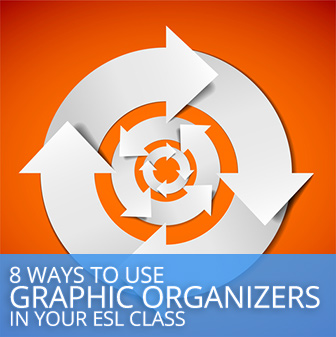8 Great Ways to Elicit Vocabulary from ESL Students


Explanations are all fine and dandy, but sometimes we need to pick up a board marker and organize concepts, vocabulary or grammar in a way that is easier and much simpler for our ESL students to grasp. And graphic organizers will help you do just that! Here are some of the most popular, and more importantly, what you can use them for in your ESL class.

Venn diagrams are perfect for comparisons and contrast. There are two circles that overlap in the middle. Students compare two things and write what they have in common in this overlapping space. The differences are written in the spaces that don’t overlap.
How to use it in your ESL class: Compare how Christmas is celebrated in the US to the way it is celebrated in your home country.
This graphic organizer is ideal for brainstorming, whether you are trying to elicit vocabulary or come up with ideas for a writing assignment. You write the topic in the center and students contribute related ideas to fill out the other circles.
How to use it in your ESL class: Write “Sports” in the center and have students brainstorm different types. From each sport, you can have circles with words related to each particular sport. Sports => Tennis => racket, net, ball, etc… Draw the cluster on the board and work together as a group or hand out individual copies for vocabulary review.
Game: Hand put copies of a cluster with a topic (“Clothes”, “Weather”) in the center and a certain number of supporting circles. The first student who fills out all of the circles correctly wins.
This is a handy way to show a sequence of events and helps students place them in the right order.
How to use it in your ESL class: Students help you place a series of events that took place in the past within the time line: (“Joe went to school at 4pm. His mother made dinner at 6pm. Joe came home at 7pm.”) Students practice the Past Perfect: “By the time Joe came home, his mother had already made dinner.”
This one is also useful to describe a sequence of events or the steps in a process.
How to use it in your ESL class: Try this sequencing activity on how to wash your hands. Use the prompts for the different steps; students must put them in the right order and use the sequencing words. Flow charts are also great for this type of activity.
Students write down the main goal in the center circle. Students come up with reasons for accomplishing this goal, and finally facts related to these reasons.
How to use it in your ESL class: Students write down their goal for the ESL course, for example, “speak English more fluently”. One of the reasons may be “need to speak English at work”. The supporting circles may be “boss only speaks English” or “all company communication is in English”.
You can also adapt the graphic and make it “cause and effects”, for example, global warming as the cause, and its various effects “extreme weather”, “increase in average global temperature” “melting of the glaciers”, etc…
You can use this graphic in the same way you’d use the Word Cluster – it’s a different graphic, but it serves the same purpose. In this case, the topic goes in the center and the supporting ideas on the spokes of the wheel.
How to use it in your ESL class: Write “Ways to Be Healthier” as your central topic. Students contribute ideas such as, “Eat more fruits and vegetables”, “Walk or ride bike instead of drive”, “Sleep at least 8 hours a day”, etc…
With the use of triangles you can go from a broad topic to a more specific one (inverted triangle) or vice versa. The triangle is a classic for the Food Pyramid where you put the foods you should eat the most at the bottom and those you should have small quantities of at the top.
How to use it in your ESL class: Use the inverted triangle and write a very general topic at the top and following with more detailed information. General topic: The weather => The weather has been changing in recent years => We are having more extreme weather events => These events include tsunamis, superstorms, and flooding due to heavy rains => The population will need to prepare for these events.
Tell your students that they must write a story in English, and most will freak out. Give them a story map to get started, and they will calm down.
How to use it in your ESL class:
You may choose to copy the graphic onto the board and complete it as class. Or hand out copies for each individual student to complete. Use them to introduce or review content. You’ll find these and more at Education Place and lots more at TeacherVision.
Never underestimate the power of using visuals – graphic organizers can really clear things up for your ESL students. Also, as you work together to complete one, you can maximize student talking time.
Which of these do you use on a regular basis? If you have any success stories to tell, share them below!